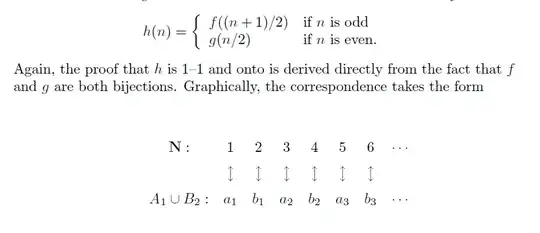We are going with countable being synonymous with countably infinite.
While trying out to define a bijection from $\mathbb{N}$ to $A \cup B$ and their peice-wise cousins, I saw five possibilies, which preserve the cardinality of $A$ and $B$:
Note: C means countable and F is for finite.
$$\begin{array} {| c | c | c |}
\hline
A \backslash B & A \cap B & B \backslash A \\ \hline
C & F & C \\ \hline
F & C & F \\ \hline
C & C & C \\ \hline
C & C & F \\ \hline
F & C & C \\ \hline
\end{array}
$$
If one observes carefully, we can group these five into two. Taking the existence of one set fully and the other set exists after the elimination of the commonality, which got adjoined to the first set.
Thus,
$A$ and $B\backslash A$
or
$B$ and $A\backslash B$
Proceeding to the result under consideration:
Theorem: If $A$ and $B$ are both countable sets, then their union $A \cup B$ is countable.
Proof:
Let $A$ and $B$ be any two countable sets.
Now, $A \cup B = A \cup (B \backslash A)$
Either $|B\backslash A| < \aleph_{0}$ OR $|B\backslash A| = \aleph_{0}$
$\underline{\text{Case 1}}$:
If $|B\backslash A| < \aleph_{0}$, then let $|B\backslash A|=n$, for some $n \in \mathbb{N}$
Let $f:J_n \rightarrow (B \backslash A)$ and $g:(\mathbb{N} \backslash J_n) \rightarrow A$ be bijections.
(Note: The set $J_u$:= The set of first u natural numbers.)
Let $h:\mathbb{N} \rightarrow A \cup B$ be a function such that
$$\begin{align}
h(x)&:=
\begin{cases}
f(x),& \text{ if } x \in J_n \\
g(x),& \text{ otherwise }
\end{cases}
\end{align}$$
$\because (B\backslash A) \cap A = \varnothing \implies f(\theta) \neq g(\mu), \forall \theta \in J_n, \forall \mu \in (\mathbb{N} \backslash J_n)$
Let for some $\alpha$, $\beta$ $\in \mathbb{N}$, $h(\alpha)=h(\beta)$
$\implies \ f(\alpha)=f(\beta)$ OR $g(\alpha)=g(\beta)$
$\implies \alpha = \beta$ OR $\alpha = \beta$ ($\because f$ and $g$ are one-one.)
$\implies h$ is one-one
Let $\eta \in A \cup B \implies \eta \in A$ OR $\eta \in B\backslash A$
$\implies \eta=f(\omega)$, for some $\omega \in J_n$ OR $\eta=g(\lambda)$, for some $\lambda \in \mathbb{N}\backslash J_n$
($\because f$ and $g$ are onto.)
$\implies \eta=h(\omega)$, for some $\omega \in J_n \subset \mathbb{N}$ OR $\eta=h(\lambda)$, for some $\lambda \in \mathbb{N}$ such that $\lambda > n$
$\implies h$ is onto.
Thus, $h$ is bijective
$$\begin{align}\implies A \cup B \sim \mathbb{N}\tag{1}\end{align}$$
$\underline{\text{Case 2}}$:
We have $B\backslash A$ as countable.
Let $y:\mathbb{N} \rightarrow A$ and $z:\mathbb{N} \rightarrow (B\backslash A)$ be bijections.
Let $k:\mathbb{N} \rightarrow A \cup B$ be a function such that
$$\begin{align}
k(w)&:=
\begin{cases}
f(\frac{w+1}{2}),& \text{ if } w \text{ is odd } \\
g(\frac{w}{2}),& \text{ otherwise }
\end{cases}
\end{align}$$
Then $k$ is bijective (by a reasoning similar to $h$ being bijective, given in $\underline{\text{Case 1}}$)
$$\begin{align}\implies A \cup B \sim \mathbb{N}\tag{2}\end{align}$$
Thus, $(1),(2)\implies$ If $A$ and $B$ are countable, then their union $A \cup B$ is countable.
